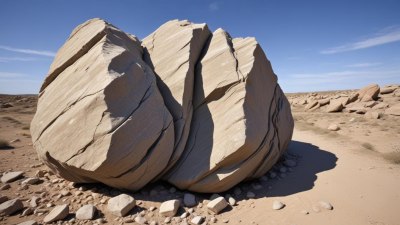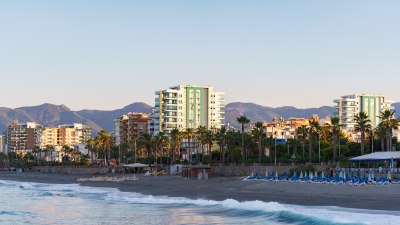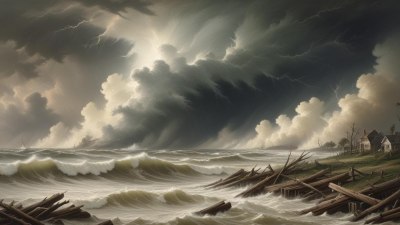How Wind Can Carve Rocks Over Time
Explore the fascinating process of how wind shapes and carves rocks over time through erosion and weathering.

This image was created with the assistance of Freepik
Throughout the ages, nature has been responsible for shaping the landscapes we see today. Among the many forces of nature, wind plays a crucial role in carving and shaping rocks. This phenomenal process is much more than a mere display of strength; it's a complex interaction of elements that contributes to erosion and the gradual transformation of the earth's surface. Understanding how wind carves rocks requires a look into various geological processes, the specific mechanics of wind erosion, and examples found across different terrains.
Understanding Wind Erosion
Wind erosion is the process by which soil and rock are removed from one location and transported to another by the force of wind. This process begins when wind blows across loose material on the ground, lifting particles into the air. These particles can range from small grains of sand to larger rock fragments. It's important to note that winds that have sufficient velocity and energy are primarily responsible for this erosive process.
To grasp the full extent of how wind can carve rocks, it's essential to consider the factors that influence wind erosion: vegetation cover, soil moisture, and wind speed. Areas devoid of vegetation are particularly susceptible to wind erosion since plants help anchor soil particles in place.
The Mechanisms of Wind Carving
Wind erosion predominantly occurs through three primary mechanisms: deflation, abrasion, and transport. Deflation refers to the removal of loose particles from the ground surface, leading to the formation of depressions and the exposure of underlying rocks. Abrasion happens when airborne particles collide with rock surfaces, effectively grinding and wearing them down. This process can lead to distinctive shapes, such as hoodoos and arches, often seen in desert regions.
Transport is the process by which eroded particles are moved by the wind. This transportation can happen over long distances, and as these particles collide with rocks, they contribute further to the carving process. Understanding these mechanisms is vital for appreciating how wind influences geological formations.
Factors Influencing Wind Erosion
Several factors influence the rate and effectiveness of wind erosion, including climate, terrain, and the types of rock present. Arid regions with loose sandy soils are more affected by wind erosion than more humid environments. Wind speed can also play a critical role; stronger winds are more capable of lifting and transporting heavier particles, thus increasing the rate of erosion.
The hardness of rock types significantly impacts how they are affected by wind erosion. Softer rocks, such as sandstone, erode more quickly compared to harder rocks like granite. Additionally, pre-existing fractures in rocks can serve as pathways for erosion, allowing wind to exploit weaknesses in the rock and enhance the carving process.
Case Studies: Wind-Carved Landscapes
Throughout the world, numerous landscapes showcase the remarkable effects of wind erosion. One quintessential example is the Badlands National Park in South Dakota, USA. This area features dramatic canyons, buttes, and pinnacles formed primarily through the effects of wind-driven erosion acting on soft sedimentary rock layers.
The Nabta Playa in Egypt offers another striking illustration of wind's erosive power. The region's rock formations exhibit various shapes carved by intense wind erosion over thousands of years. In contrast, the remarkable rock formations of the Valley of Dreams in New Mexico highlight the creative artistry of wind erosion, where soft volcanic rocks have been sculpted into intricate and unusual forms.
The Role of Time in Rock Carving
One of the most significant aspects of wind erosion is the time it takes to achieve noticeable alterations to rock surfaces. Geological processes are often slow, requiring thousands to millions of years to shape the environment dramatically. For instance, the famous rock formations in Monument Valley have been carved over millions of years, illustrating how prolonged exposure to wind can result in magnificent shapes.
Similar processes can be observed in the iconic rock formations of the Arizona desert. The distinctive spires and formations in this region are a testament to the slow yet persistent effects of wind erosion, showcasing nature's patience and ability to sculpt landscapes.
Human Activity and Wind Erosion
While wind erosion is a natural phenomenon, human activities can exacerbate its effects. Urbanization, deforestation, and agricultural practices can destabilize soil and create conditions conducive to wind erosion. For instance, land that is cleared for agriculture can lead to the exposure of loose soil, making it easier for wind to pick up and transport particles.
Efforts to control wind erosion often involve reinstating vegetation, as planting trees and grass can significantly reduce the speed of wind at ground level and help keep soil anchored in place. This approach not only preserves the land but also contributes to enhancing biodiversity and the overall health of ecosystems.
Preventing Wind Erosion
Preventive measures against wind erosion are crucial for preserving landscapes and preventing the degradation of vital ecosystems. Sustainable land management practices can mitigate wind erosion's harmful impacts. For example, farmers can employ contour farming, no-till methods, and the establishment of windbreaks to protect arable land and reduce soil degradation.
Conservation practices have been implemented successfully in various places around the globe to combat wind erosion. In areas prone to sandstorms, like the Sahel region in Africa, widespread afforestation efforts have been undertaken to restore vegetation and stabilize soil, leading to a reduction in erosion and improvements in local climates.
The process by which wind carves rocks is a testament to the power of nature. Through mechanisms such as deflation, abrasion, and transport, wind alters landscapes over time, creating some of the most iconic geological formations we see today. As factors such as human activity and climate change threaten to intensify wind erosion, the importance of understanding this natural phenomenon cannot be understated. By learning from the representative landscapes that tell the story of wind erosion, we can better appreciate the delicate balance between natural forces and human intervention in shaping our planet's future.











